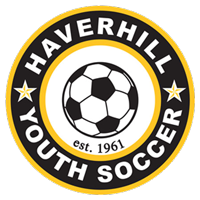Weather
Haverhill Youth Soccer believes everyone should be aware of the potential dangers posed by different weather conditions and work together to keep players and other participants as safe as possible. Technology has improved the monitoring capability for all concerned and there are many new apps for phones and tablets that provide accurate and timely weather reports, forecasts and warnings.
HYS strongly recommends that all coaches have the latest weather apps loaded on their phones to include instant weather alerts and lightning strike notifications.
Severe Weather
Severe storms can produce high winds, heavy rain, hail, lightning, thunder and/or tornadoes. If a severe storm approaches the playing area, the safety of the players is the number one priority of coaches and referees, and may require that the play be suspended while shelter is sought. In the event play is suspended, ALL participants MUST clear the field immediately and move into their cars or other permanent shelter.
Lightning
Lightning is the second leading cause of storm-related deaths and can strike up to 10 miles outside of a thunderstorm, literally a bolt from the blue. If a person can hear thunder or see lightning, the danger is already is present. A clear, sunny sky overhead with storm clouds nearby can still be dangerous. The danger from lightning can persist for 20-30 minutes or more after a thunderstorm has passed.
The National Weather Service does not issue watches or warnings for lightning by itself. However, the National Weather Service does advise that if you see a lightning bolt and hear the thunder in 30 seconds or less, you seek shelter and wait 30 minutes before resuming outdoor activity.
If lightning is within five miles, with or without hearing thunder, play should be suspended and shelter sought. A lightning detector or similar app can identify the distance accurately but may not be available.
A rough guideline is to measure the time between the lightning flash and hearing the corresponding thunder. If it is 30 seconds or less, seek shelter. It may not be possible to determine which lightning strike generated which roll of thunder.
A simple rule: If you can see it or hear it, clear it!
HYS recommends that participants seek immediate shelter in their automobiles or a designated severe weather shelter, if one is nearby. Smaller, open structures, tents, trees, isolated areas, etc, should be avoided. Cars with windows rolled up or buses can provide good shelter. Avoid contact with metal or other conducting materials to the outside surfaces. Do not stay in open, unprotected areas.
Play should not be restarted for at least 30 minutes after the last lightning strike is seen or roll of thunder is heard.
Hot Weather
Extreme heat can impact players' health and safe play. Proper hydration and knowing when you need to drink are critical, to help prevent many injuries and illnesses, from muscle cramps to heat stroke.
Players should drink water before, during and after a training session or game, which means coaches should make sure there is adequate water available.
A heat index chart will be given to every coach.
All coaches will be provided with training to teach the signs of heat exhaustion and heat stroke.
Heat Index: Action
Up to 84°: Normal play.
85° - 89°: Mandatory two-minute water break per half with running time.
90° - 99°: Mandatory two-minute water breaks per half with running time. Each half shortened by five minutes.
100° - 104°: Mandatory two-minute water breaks per half with running time. Each half shortened by ten minutes.
105°+: Suspend play.
Cold Weather
For fall play, cold becomes a factor. Players should be allowed to dress in appropriate clothing. Field conditions will be affected by freezing rain, sleet and snow. The ground may become frozen and be unsafe for play.
Players on sidelines should remain dressed, if in warm-ups, until playing.
Players coming off the field should towel off, if sweaty, and get dressed quickly.
No one should sit or lie directly on ground. Heat is lost faster to ground than to air. Blankets and chairs are recommended.
Keep hydrated and avoid caffeine or carbonated drinks.
Keep an eye on field conditions, as cold wet weather can quickly change footing from safe to slippery.
Keep an eye on the goalkeeper - usually the player who gets coldest first, as they are not running or moving like a field player.
Wind Chill Index: Action
46° and higher: Normal play.
45° and lower: Allowable Additional Clothing
Layers beneath uniform.
Gloves or mittens.
Stocking caps without straps.
Sweat pants or shirts - Underneath the uniform.
Jackets - Underneath the uniform.
Clothing NOT Allowed:
Hooded sweatshirts - Hoods and strings present possibility of being grabbed.
Ear muffs - Plastic or metal part crossing top of head presents potential hazard.
Scarves - Isadora Duncan Syndrome.
40° and lower: Each half shortened by five minutes.
35° and lower: Suspend play.
Updated April 18, 2018
